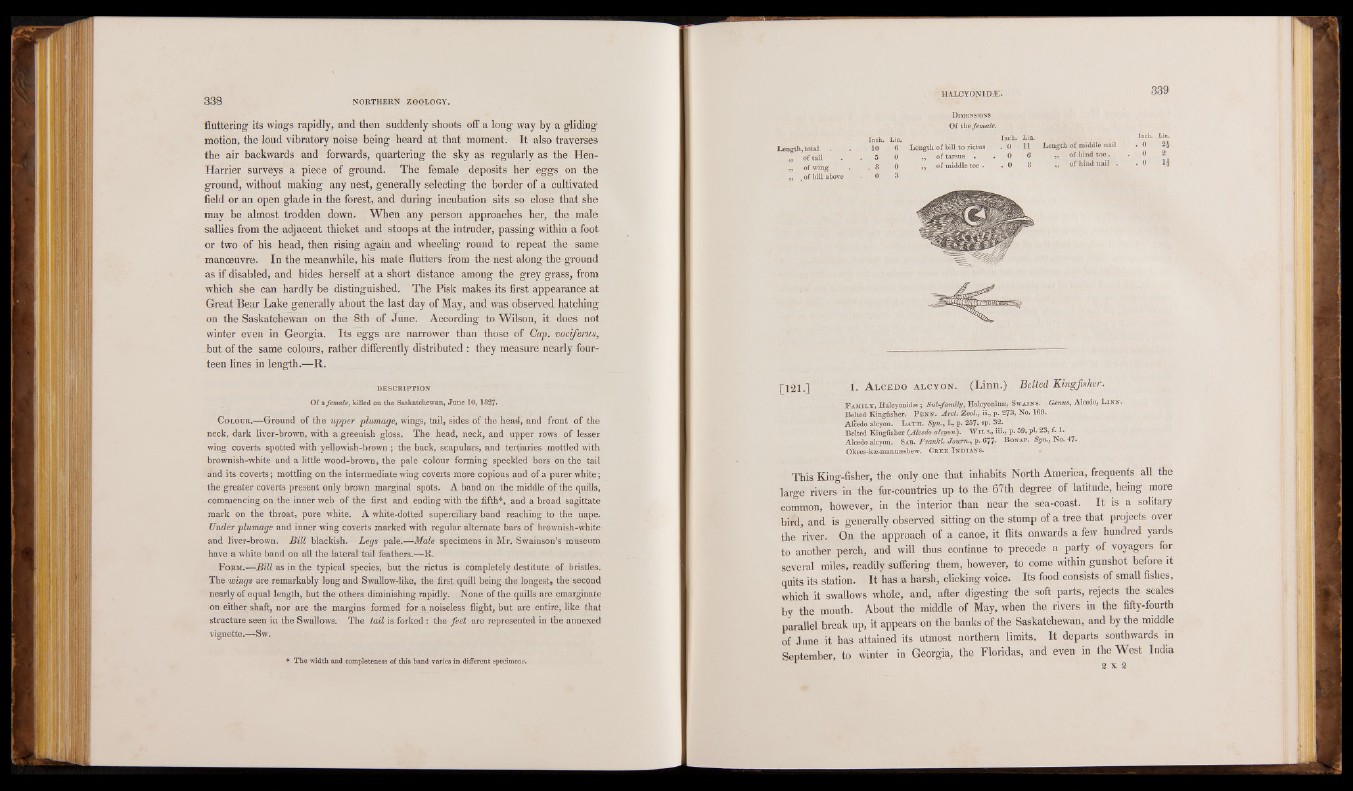
fluttering its wings rapidly, and then suddenly shoots off a long way by a gliding
motion, the loud vibratory noise being heard at that moment. It also traverses
the air backwards and forwards, quartering the sky as regularly as the Hen-
Harrier surveys a piece of ground. The female deposits her eggs on the
ground, without making any nest, generally selecting the border of a cultivated
field or an open glade in the forest, and during incubation sits so close that she
may be almost trodden down. When any person approaches her, the male
sallies from the adjacent thicket and stoops at the intruder, passing within a foot
or two of his head, then rising again and wheeling round to repeat the same
manoeuvre. In the meanwhile, his mate flutters from the nest along the ground
as if disabled, and hides herself at a short distance among the grey grass, from
which she can hardly be distinguished. The Pisk makes its first appearance at
Great Bear Lake generally about the last day of May, and was observed, hatching
on the Saskatchewan on the 8th of June. According to Wilson, it does not
winter even in Georgia. Its eggs are narrower than those of Cap. vociferus, but of the same colours, rather differently distributed : they measure nearly fourteen
lines in length.—R.
DESCRIPTION
Of a female, killed on the Saskatchewan, June 10, 1827.
C olour.— Ground of the upper plumage, wings, tail, sides of the head, and front of the
neck, dark liver-brown, with a greenish gloss. The head, neck, and upper rows of lesser
wing coverts spotted with yellowish-brown ; the back, scapulars, and tertiaries mottled with
brownish-white and a little wood-brown, the pale colour forming speckled bars on the tail
and its coverts; mottling on the intermediate wing coverts more copious and of a purer white;
the greater coverts present only brown marginal spots. A band on the middle of the quills,
commencing on the inner web of the first and ending with the fifth*,. and a broad sagittate
mark on the throat, pure white. A white-dotted superciliary band reaching to the nape.
Under plumage and inner wing coverts marked with regular alternate bars of brownish-white
and liver-brown. Bill blackish. Legs pale.—Male specimens in Mr. Swainson’s museum
have a white band on all the lateral tail feathers.—R.
F orm.—Bill as in the typical species, but the rictus is completely destitute of bristles.
The wings are remarkably long and Swallow-like, the first quill being the longest, the second
nearly of equal length, but the others diminishing rapidly. None of the quills are emarginate
on either shaft, nor are the margins formed for a noiseless flight, but are entire, like that
structure seen in the Swallows. The tail is forked : the feet are represented in the annexed
vignette.—Sw.
The width and completeness of this band varies in diiferent specimens.
Length, total 10
Lin.
6
of tail . 5 0
„ of wing . 8 0
„ , of bill above 0 3
Dimensions
Of the female.
. Inch. Lin.
Length of bill to rictus • . 0 11
„ of tarsus • . 0 6
,, of middle toe • . 0 8
Inch. Lin.
Length of middle nail • 0 2J
„ of hind toe. . 0 2
„ of hind nail . • 0 l£
[121.] 1- A l c e d o a l c y o n . (Linn.) Belted Kingfisher.
F a m il y , Halcyonidae; Sub-family, Halcyoninse, Sw a in s. Genus, Alcedo, L in n .
Belted Kingfisher. Penn. Arct. Zool., ii., p. 273, No. 169.
Alcedo alcyon. L a t h . Syn., i., p. 257, sp. 32.
Belted Kingfisher (Alcedo alcyon). Wins., iii., p. 59, pi. 23, f. 1.
Alcedo alcyon. Sab. Frankl. Joum., p. 677« B onap. Syn., No. 47.
Okees-kie-mannseshew. Cb.e e I n d ia n s.
This King-fisher, the only one that inhabits North America, frequents all the
large rivers in the fur-countries up to the 67th degree of latitude, being more
common, however, in the interior than near the sea-coast. It is a solitary
bird, and is generally observed sitting on the stump of a tree that projects over
the river. On the approach of a canoe, it flits onwards a few hundred yards
to another perch, and will thus continue to precede a party of voyagers for
several miles, readily suffering them, however, to come within gunshot before it
quits its station. It has a harsh, clicking voice. Its food consists of small fishes,
which it swallows whole, and, after digesting the soft parts, rejects the scales
by the mouth. About the middle of May, when the rivers in the fifty-fourth
parallel break up, it appears on the banks of the Saskatchewan, and by the middle
of June it has attained its utmost northern limits. It departs southwards in
September, to winter in Georgia, the Floridas, and even in the West India